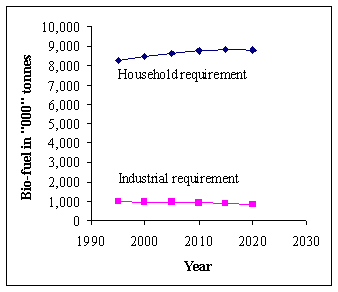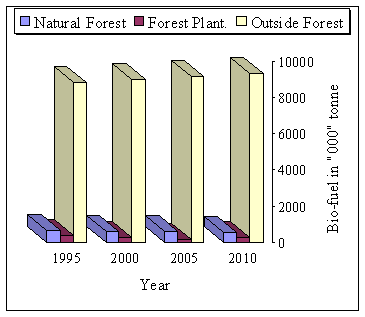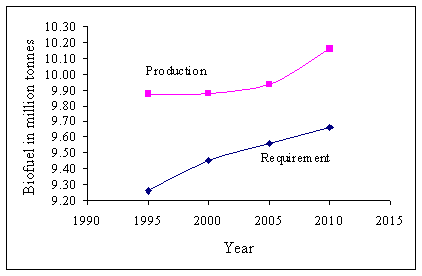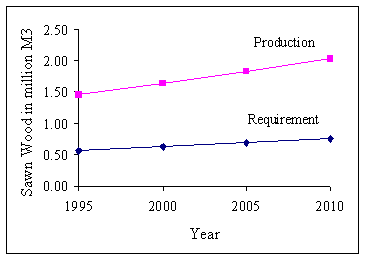


This chapter presents use of forest resources in Sri Lanka including trees outside forest areas. It provides information on marketed and non-marketed forest products including Non Timber Forest Products, which are very important in the rural economy as a contributor to subsistence support, cash income and employment to the rural poor.
Sri Lanka currently enjoys almost self-sufficiency in meeting its domestic requirement of forest products except for plywood, paper and paperboards. The growing emphasis on sustainable management of remaining natural forests and conservation of biodiversity may reduce the sustainable levels of supply and limit the current production possibilities of saw mills and plywood industries.
The Non Timber Forest Products (NTFP) are contributing to the raw material for small industries, earning foreign exchange from the export of both unprocessed and processed products in addition to helping rural poor. Most important NTFP in Sri Lanka are medicinal plants, rattan, bamboo, products of kithul palm, and edible plants. Due to incomplete data on extraction rates, market prices, and time spent on collection and consumption etc., it is difficult to assess the total contribution of NTFP to the society.
Price and availability are the main factors that determine the use of alternative sources of energy in Sri Lanka (FSMP, 1995). The fuelwood continues to be the cheapest source of energy for industries as well as households. It satisfies about 49 percent of the total industrial energy consumption. The tea, hotel, brick and tile industries together account for about 73 percent of total industrial fuelwood consumption. The households consume about 61 percent of total energy and their share in total energy consumption is steadily increasing while that of the industry is declining.
Various studies (Wijesinghe, 1983, FMP, 1985 and FSMP, 1995) have assessed (Table 36 at Annex) the household consumption of fuelwood in Sri Lanka. The last study by FSMP (1990) is more intensive than the past studies and is based on the following four basic assumptions; declining per capita consumption, increasing population, declining percentage of population using bio-fuels, and increase in real Gross Domestic Product. This study provides the estimates of per capita daily household consumption of fuelwood, projection of domestic fuelwood consumption for next three decades (Table 37 at Annex), and industrial fuel wood consumption (Table 38 at Annex). The study indicates a decline in the industrial bio-fuel requirements (Table 39 at Annex) due to improved technology of fuelwood consumption in the Tea sector, which alone consumes maximum (43.2%) amount of industrial fuelwood in Sri Lanka.

Fig. 9. Requirement of biofuels
The share of bio-energy in the total energy production of the country has remained roughly the same (66% in 1992 to 68% in 1982). Table 40 at Annex presents bio-energy estimates at the national level by each district to indicate the spatial variation in the balance (gap) between demand and supply of bio-fuel. Rubber plantations provide about one-sixth, crop residues about one-third and other sources provide rest of the bio-fuel (Table 41 at Annex). The trees outside forest make maximum contribution (Fig. 9), followed by the natural forest and the forest plantations (Table 42 at the Annex).

Fig. 10. Contribution of different landuse to biofuels
At the National level, the production of bio-fuels from TOF makes Sri Lanka surplus in bio-fuels (Table 43 and 44 at Annex). Among TOF, the total contribution of rubber towards total bio-energy is about 17 percent and that of coconut is about 22 percent. Recent increases in demand of rubber for sawn wood are reducing its current and future contribution to the supply of industrial fuelwood. However, FSMP (1995) expects that with increase in production from other trees under TOF, the total production of bio-fuel is likely to improve in the near future (Figure 11).

Fig. 11. Production and Requirement of Bio-fuels
Forest Sector Master Plan (FSMP, 1995) estimates that sawn wood requirement will increase from 0.031M3 per capita in 1993 to 0.039 M3 in 2020 and the requirement of wood as fibre for paper pulp will remain constant due to the low levels of availability of domestic raw material despite of expected growth in the demand of paper at the rate of 4.3 percent per annum. The FSMP forecasts that the requirement of wood for plywood may even decline as some of the old pulpwood plants may close down due to obsolescence and inefficiency. It indicates that the demand of wooden electricity poles will stay around 20 to 25 thousand poles (300 m3) due to limited domestic supply and that of telephone poles may even decline due to their replacement with concrete poles.
FSMP, 1995 estimates that production of wood from natural forest will decline (Figure 12) and that from forest plantation and TOF will increase over years (Table 44 at Annex). The FSMP estimation is based on the following assumptions,
Fig. 12. Production of Wood from different sources
The domestic production of wood is sufficient to meet about 95 percent of the national requirements (Table 43 and 44 at Annex). Like bio-fuels, Sri Lanka is in a comfortable position (Table 45 at Annex) with surplus in production of sawn wood (Figure 13). This surplus is likely to increase with expected increase in production from plantations and TOFs (Table 46 to 53).

Fig. 13. Production of Sawn Wood
A recent census (1995) of timber based enterprises in 19 districts of Sri Lanka indicates that most of timber-based enterprises are not been registered with the Forest Department and their use spans about 203 species. Such diversity of species used for timber is more in modern cities and less in other cities. The maximum demand of timber is for furniture, roofing and doorframes.
The case of plywood is just reverse, where imports meet majority (82%) of the national requirement (0.28 million M3 in 1993). The particleboard and fibre board industries depend entirely on the imports. The domestic resources contribute about 61% of the national requirement of about 0.031 million tonnes of fibre for making paper and the balance (39%) quantity is imported. The main domestic source is waste paper and the wood contributes very little (6%) for this purpose. The domestic industry uses old technology and needs lot of investment for modernization. Accordingly, the domestic production of paper contributes only about 21.5 percent towards satisfaction of the total national consumption (0.130 million tonnes 1993) of paper.
The Rubber productions during last few years have declined by about six percent mainly because of fall in prices, shortage of labor, increase in rainy days, and low fertilizer application. The average export price has declined by five percent and the average cost has increased by ten percent leading to decline in the profitability of rubber production. More than sixty percent of the production is exported to other countries. The impact of "East Asian Currency Crisis," coupled with low profitability and low yields have adversely affected "Rubber" growers. Lower levels of replanting and "new planting" clearly demonstrate this impact.
About fifty percent of the rural people in Sri Lanka use more than 1000 plant species as Ayurveda medicine out of a total of about 3,500 plant species identified in the country. The level of employment in the medicinal plant sector is not known, as extraction is not recorded, and is not done on a full time basis. Most of the families living close to the natural forests collect medicinal plants but there are no estimates of total quantity of medicinal plants used in the country or their prices. Table 54 at Annex attempt to indicate the level of medicinal herbs collected by an average family based on a small socio-economic survey (IUCN, 1995). Table 55 at Annex presents some information about the international trade of medicinal plants and herbs in Sri Lanka. In recent years, both the imports and exports of medicinal plants have increased. These exports are mainly to India, Pakistan, France and the Netherlands.
Rattans (Calamus spp.) are spiny climbing plants, which are mainly used in furniture, ornaments, housing and construction, as utensils, and binding material. Eight out of ten species (Table 56 at Annex) of Rattan present in Sri Lanka, are exploited for commercial purposes. It provides employment to about 2,200 craftsmen from 700 families, which is about three times more than from bamboo. The rattan industry is spread over 13 districts. Tourists and expatriates purchase about 65% of the high quality rattan products. The demand of rattan products far exceed local production, therefore, the producers of high quality rattan furniture import rattan from Indonesia, Singapore, and Malaysia because of the scarcity of good quality rattan in Sri Lanka.
Bamboo resources in Sri Lanka are not as abundant as in many South Asian countries, and consequently the importance of bamboo in the household economy, construction, and in cottage industry is comparatively less. The availability of indigenous bamboo species in forest areas, such as Ochlandra stridula, is decreasing because of deforestation and over-exploitation. However, they can still be found abundantly in a few areas, e.g. in Ratnapura and Kalutara Districts.
The bigger diameter bamboos are mostly introduced species (Bambusa vulagris and Dendracalamus giganteus), which are cultivated (Table 46 at Annex) in homegardens, and along roadsides and riverbanks. The bamboo handicraft industry uses B. vulgaris and O. stridula species and the construction industry uses B. vulagris and D. giganteus. Bamboo industry supports about 250 families and 690 workers. According to a survey by the Forest Department about 80 percent of people who collect bamboos process it for household consumption and rest 20 percent people either process it for domestic use as well as sell them to processors. The price of bamboo has increased much faster than the rate of inflation, which suggests that the availability of bamboo has gone down in relation to the demand.
Kithul or Kitul (Caryta urens) is a multiple-use tree of considerable economic value in Sri Lanka. Its pith is used for food, medicine, fodder and wood. The sap is tapped from the flowering shoot for "toddy" (a hard drink), "treacle", and jaggery. Figures of employment provided by Kithul are not available. A special caste of people that live in two major clusters in the natural forests, tap the sap and make jaggery. Table 58 at Annex presents an estimate of income from Kitul products (CR, 1997.
There is a relationship between ecological zones and the percentage of households that collect edible plants from the local forests. In the intermediate and dry zones, about 60 to 70 percent of the households collect edible plants whereas in montane zones, only about 20 percent of the households collect the edible plants. The Table 59 at Annex contains an estimate of annual income generated by rural communities living adjacent to the forests by selling edible plants.
Sri Lanka currently enjoys almost self-sufficiency in meeting its domestic requirement of forest products except for plywood, paper and paperboards. The current strategic planning for sustainable management of remaining natural forests and conservation of biodiversity t may reduce the sustainable levels of supply. The FSMP, 1995 estimates that production from natural forest will decline and that forest plantation and TOF will increase over years. The use of Non Wood Forest Products (NWFPs) is very common and linked with local culture vegetation and ecology. NWFPs are also means of livelihood for many poor people.